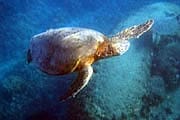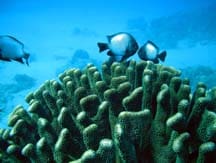Show Hawaiian Marine Life Aloha
Take nothing but pictures – touch nothing but hearts. The desire to care for our natural environment is instinctual, and that desire becomes stronger the closer we are to that environment, physically or emotionally. Every year, over 5 million people will venture into Hawaii’s near shore waters.
Please do not attempt to touch, ride, hug, kiss, feed or pet Hawaii’s marine wildlife.
Although we can’t guarantee the “mood” or sightings of particular marine life, we can guarantee that by practicing the guidelines below you will ensure the best wildlife encounters possible during your stay in Hawaii.
Dolphins
Cautiously move away if you observe any of the following behaviors:
Rapid changes in swimming direction or speed
- Escape tactics such as prolonged diving, underwater course changes, or rapid swimming away from your location at the surface.
- An adult attempting to shield calf with body or by movements.
- Sudden stop in important breeding, nursing, feeding or resting activities upon your arrival.
- Review swim encounter guidelines
Sea Turtles
Sea Turtles require air to live. If you see them rising to surface, give them room to breath. Ensure that your presence does not disturb them.
- Cautiously move away if you observe any of the following behaviors:
- Sudden awakening from a sleep-like state on the seafloor.
- Movement away from or increase in swim speed upon disturbance.
- “Yawning” motions or “Flipper Swipe” over their eye
Fish and Coral Reefs
“It takes 1000 years for a 1000 year old reef to repair itself.” – Dave Gulko
No peas please! Feeding fish frozen peas or any other food can cause illness or death and disrupt natural fish populations.
- Do not attempt to touch fish or any marine life.
- In shallow water, avoid stepping on or touching coral heads.
- Watch “Hawaii Reef Etiquette” for a head start on showing our oceans Aloha.
Hawaiian Monk Seals
Hawaiian monk seals are one of the most endangered seal species in the world.
- Ensure that your presence does not disturb them; observe them from at least 50 yards away .
- In the ocean, monk seals may show inquisitive behavior. Do not attempt to approach these seals or “play” with them. The seals may misread your actions, can move quicker than you think which can result in serious injury. Watch them from a safe vantage point.
In-Water Best Practices
As marine operators, we will attempt to avoid influencing the natural behavior of any marine life, and will encourage our guests to do the same. It is our intention to provide as natural a viewing experience as possible for our guests while interacting with the marine environment.
Everyone will:
- Avoid touching or taking any marine organism or their habitat, living or not, (rocks, turtles, dolphins, whales, fish, or invertebrates, etc.).
- Be aware of our body and equipment so as to avoid contact with the reef or other marine life.
- Not approach any marine life within arm’s reach for any reason.
- Not approach turtles within 3 body lengths and will avoid impeding a turtle’s path to the surface for breathing.
- Protect ourselves and marine life and their habitat by not FEEDING them to; make animals less agressive, protect marine life from injesting harmful foods, protect the balance of the marine ecosystem, and let the fish do their job.
- Apply sunscreen 30 minutes before entering the water. Reef safe sunscreen is preferred, we have this onboard.
- Use biodegradable defog.
Please be aware
Federal Law no longer allows us to get in the water with Hawaiian spinner dolphins in shallow water. Any in-water interactions with dolphins will be offshore and/or with one of our 17 other species of dolphins around Hawaii. Those opportunities are less frequent and always dependent on a variety of conditions including animal behavior.

 Rapid changes in swimming direction or speed
Rapid changes in swimming direction or speed Sea Turtles require air to live. If you see them rising to surface, give them room to breath. Ensure that your presence does not disturb them.
Sea Turtles require air to live. If you see them rising to surface, give them room to breath. Ensure that your presence does not disturb them. No peas please! Feeding fish frozen peas or any other food can cause illness or death and disrupt natural fish populations.
No peas please! Feeding fish frozen peas or any other food can cause illness or death and disrupt natural fish populations. Hawaiian monk seals are one of the most endangered seal species in the world.
Hawaiian monk seals are one of the most endangered seal species in the world.